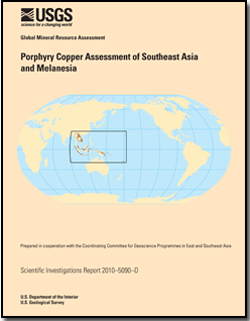 Abstract
Abstract
The U.S. Geological Survey collaborated with member countries of the Coordinating Committee for Geoscience Programmes in East and Southeast Asia (CCOP) on an assessment of the porphyry copper resources of Southeast Asia and Melanesia as part of a global mineral resource assessment. The region hosts world-class porphyry copper deposits and underexplored areas that are likely to contain undiscovered deposits. Examples of known porphyry copper deposits include Batu Hijau and Grasberg in Indonesia; Panguna, Frieda River, and Ok Tedi in Papua New Guinea; and Namosi in Fiji.
This assessment covers the countries of Cambodia, Indonesia, Lao People’s Democratic Republic, Malaysia, Myanmar, Papua New Guinea, Singapore, Thailand, and parts of southeastern China, India, the Solomon Islands, Vanuatu, and Fiji. Twenty-two geographic areas were delineated as tracts that are permissive for porphyry copper deposits in Southeast Asia. Permissive tracts are grouped into four broadly defined geographic/geologic areas, as follows: (1) the Indochina Peninsula area, (2) Indonesian and Malaysian Islands, (3) New Guinea Island and Papuan New Guinea islands, and (4) Melanesia. Individual tracts range from less than 1,000 to more than 350,000 square kilometers in area. Permissive tracts are based on mapped and inferred subsurface (<1 kilometer depth) distributions of igneous rocks of specific age ranges that define magmatic arcs and magmatic belts that are likely to contain porphyry copper deposits. Most of these magmatic arcs are subduction-related, although some have porphyry-style deposits occurring in postcollisional and (or) poorly understood tectonic settings. Although maps at a variety of different scales were used in the compilation, the final tract boundaries are intended for use at a scale of 1:1,000,000.
Global grade and tonnage models for porphyry copper deposits were evaluated. Most of the known deposits are best described as fitting the copper-gold (Cu-Au) subtype of porphyry copper deposit. For some permissive tracts, a general porphyry copper-gold-molybdenum (Cu-Au-Mo) model was used. Assessment participants estimated numbers of undiscovered deposits at different levels of confidence for most of the permissive tracts. These estimates were combined with grade and tonnage models using a Monte Carlo simulation to estimate undiscovered resources. Additional resources in extensions of deposits with identified resources were not evaluated.
Assessment results, presented in tables and graphs, show mean amounts of metal and mineralized rock in undiscovered deposits at different quantile levels, as well as the arithmetic mean for each tract.
This assessment estimated a mean of 89 undiscovered porphyry copper deposits for the assessed permissive tracts in Southeast Asia and Melanesia. About 288 million metric tons (Mt) of copper and 18,000 metric tons (t) of gold, as well as byproduct molybdenum and silver, could be associated with undiscovered deposits. This represents about four times the number of deposits with identified resources (23) already discovered in Southeast Asia; reliable reported identified resources for those 23 deposits total 84 Mt of copper and 6,000 t of gold. Eleven permissive tracts have no known porphyry copper deposits with reported resources. Three of those 11 tracts lacked sufficient information for a probabilistic assessment and are discussed in qualitative terms.
On a regional basis, both the Indochina Peninsula area and the Indonesian-Malaysian Islands area are estimated to contain about 10 times as much in place copper in undiscovered porphyry copper deposits as has been identified to date. For the New Guinea Island areas, the ratio of undiscovered to identified copper resources is about 2. Some parts of the region have a long history of porphyry exploration cycles and mine development, interrupted at times by political and social unrest, environmental concerns, and natural disasters. Changes in mining laws within the region and the recent high price of gold on the world market have prompted renewed interest in porphyry copper deposits in Southeast Asia and Melanesia. However, predicted undiscovered deposits may not be found, and if found, may not be developed.
This assessment includes an overview of the assessment results with summary tables. Detailed descriptions of each tract are included in appendixes, with estimates of numbers of undiscovered deposits, and probabilistic estimates of amounts of copper, molybdenum, gold, and silver that could be contained in undiscovered deposits for each permissive tract. A geographic information system (GIS) that accompanies the report includes tract boundaries and a database of known porphyry copper deposits and significant prospects.